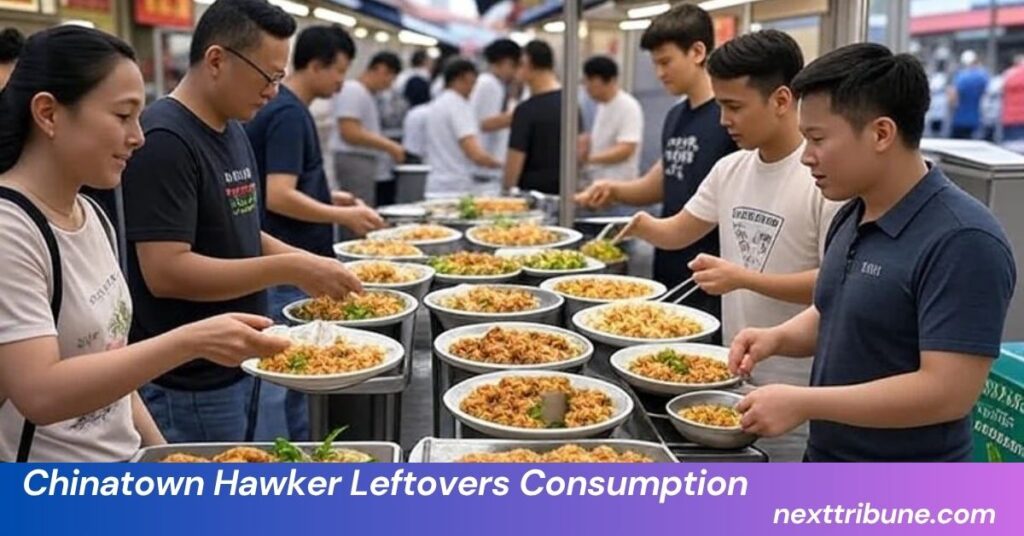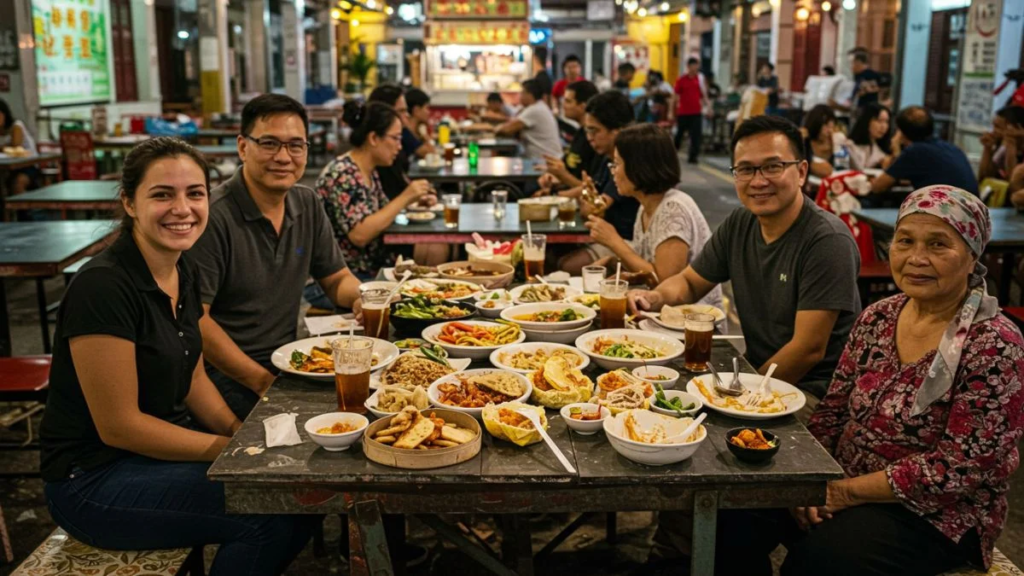
In the bustling streets of Chinatown, food stalls offer an authentic culinary experience unlike any other. The hustle and bustle of these vibrant markets reflect not only the rich cultural heritage of the area but also an evolving dynamic between food, waste, and sustainability. One unique phenomenon that has gained attention in recent years is Chinatown hawker leftovers consumption. This concept, which might seem foreign to some, is rooted in cultural practices and socio-economic factors. In this article, we’ll delve into what Chinatown hawker leftovers consumption entails, why it happens, its benefits, and the challenges it presents. Through a detailed exploration, we aim to give you an in-depth understanding of how this practice fits within the broader context of food culture in Chinatown.
Understanding Chinatown Hawker Culture
To fully appreciate the significance of Chinatown hawker leftovers consumption, we first need to understand the concept of a “hawker.” Hawker centers are bustling food courts found predominantly in Southeast Asia. These centers are home to a variety of food vendors selling affordable and traditional dishes, often prepared in open-air kitchens.
In many of the world’s most famous Chinatown districts—whether in Singapore, Malaysia, or other regions—the hawker stall culture thrives. These food vendors often offer dishes that are deeply tied to the region’s history, blending flavors from various ethnic groups such as Chinese, Indian, and Malay. The culinary choices range from dumplings and noodles to curries and satays, with each dish reflecting generations of tradition.
However, one key factor that affects this culture is the volume of food prepared daily at these hawker stalls. Due to high customer demand, many hawkers prepare large quantities of food. As the day progresses, leftover food accumulates, especially towards the closing hours. This is where Chinatown hawker leftovers consumption enters the conversation.

What Is Chinatown Hawker Leftovers Consumption?
Chinatown hawker leftovers consumption refers to the practice of consuming food that remains unsold or uneaten by the end of the day at hawker stalls. Leftover food, in this context, can range from uneaten portions on customers’ plates to surplus dishes prepared but not ordered by customers.
While many hawkers throw away unsold food, others repurpose leftovers to serve to customers at discounted rates. In some cases, these leftovers are consumed by staff or sold at a fraction of the original price to reduce food waste. The practice of eating leftover food is not unique to Chinatown; however, its presence in these markets has raised both ethical and environmental questions about food waste.
Also Read: Foenegriek: The Ultimate Guide
The Ethical Dilemma: Food Waste vs. Repurposing
The practice of Chinatown hawker leftovers consumption brings to light the larger issue of food waste in modern societies. According to recent reports, millions of tons of food are wasted each year, and a significant portion of that waste comes from the hospitality industry. In a place like Chinatown, where space is limited, and resources are precious, the question of whether leftovers should be repurposed or discarded is one that many hawker stall owners and consumers grapple with.
Repurposing leftovers might seem like a logical choice, especially given the growing concern for sustainability. Leftover food, if consumed responsibly, can be a way of reducing waste. However, some argue that it may compromise food safety standards or the quality that customers expect from these eateries. While leftover food might still be safe for consumption in certain instances, the risk of contamination increases as food is stored improperly or for extended periods.
On the other hand, throwing away food leads to unnecessary waste, especially in communities where food security is an ongoing concern. For Chinatown hawkers, who operate within tight margins, throwing away food is not just an environmental issue but an economic one. As food prices rise, hawkers are increasingly looking for ways to minimize waste, and Chinatown hawker leftovers consumption may be an attempt to address this.
The Economic Side of Leftovers
Hawker stalls operate on a thin profit margin, making every meal sold crucial to their livelihood. The decision to sell or consume leftovers can make a significant difference. Here are a few reasons why hawkers might choose to repurpose or sell leftovers:
1. Cost Efficiency
Chinatown hawkers typically purchase ingredients in bulk to keep costs low. If food is not sold, it represents a financial loss. Repurposing leftovers allows hawkers to recover some of that cost. For example, leftover rice may be repurposed into fried rice, or unused meat might be used to create a new dish. This reduces the overall waste and improves profit margins.
2. Reduced Environmental Impact
Food waste contributes heavily to environmental degradation. Leftover food, if disposed of improperly, adds to landfills, emitting greenhouse gases like methane. The idea of Chinatown hawker leftovers consumption offers a sustainable solution, helping to alleviate some of the environmental burden.
3. Customer Demand for Affordable Meals
In some parts of Chinatown, particularly in areas where tourists and locals intermingle, there’s growing demand for affordable meals. Selling leftovers at a reduced price can cater to this demand while reducing waste. The affordable pricing is appealing to students, low-income individuals, and those seeking a quick meal.
Also Read: Hitaar: Significance, Uses, and Spiritual Importance
How Do Customers Perceive Chinatown Hawker Leftovers?
When it comes to Chinatown hawker leftovers consumption, customer perceptions play a crucial role. In general, consumers are becoming increasingly aware of sustainability and waste reduction practices. Many customers appreciate the idea of leftover food being reused or resold, as long as it doesn’t compromise safety or quality. However, others may have reservations, associating leftover food with lower quality or hygiene issues.
Some customers are supportive of the practice, believing it provides them with an opportunity to enjoy great food at a fraction of the cost. Others, particularly those who are unfamiliar with hawker culture, may be hesitant to buy leftovers, fearing contamination or a lack of freshness.
The Role of Hygiene and Trust
Hygiene is a primary concern in hawker centers, where food safety is a constant issue. It is essential for hawkers to maintain high standards of cleanliness and food safety to ensure that leftovers are safe to consume. In places like Singapore, health and safety regulations are strict, and hawker stalls must meet hygiene standards set by the government. For Chinatown hawker leftovers consumption to be accepted, there must be transparency and trust between the vendor and the consumer.
The Cultural Influence of Leftover Food Consumption in Chinatown
In many cultures, particularly in Asian countries, there is a strong emphasis on not wasting food. For instance, Chinese culture has long been associated with the belief that wasting food is disrespectful. Food represents more than just sustenance; it is a symbol of respect for nature, ancestors, and community.
In the context of Chinatown, hawker leftovers consumption can be seen as a cultural extension of this philosophy. Instead of discarding uneaten food, many hawkers and customers alike may choose to consume leftovers as a way of showing respect for the effort that went into preparing the meal.
Addressing the Future of Chinatown Hawker Leftovers Consumption
As sustainability becomes more important worldwide, the practice of Chinatown hawker leftovers consumption is likely to continue to evolve. Here are some key trends to look out for:
- Technology and Innovation: With the rise of food tech, some hawkers may turn to innovative ways of minimizing food waste, such as creating apps that allow customers to purchase discounted leftover meals. These platforms could foster a sense of community while helping reduce waste.
- Regulation and Policy: As food safety concerns grow, regulatory bodies might implement new rules to ensure leftover food can be safely consumed or repurposed. This could involve stricter hygiene protocols, labeling requirements, or partnerships between hawkers and waste management programs.
- Consumer Education: The practice of consuming leftovers may be more readily accepted if customers are educated about the benefits of reducing food waste. Marketing campaigns, alongside food waste awareness initiatives, could help shift public perception and normalize Chinatown hawker leftovers consumption.
Also Read: Pedro Vaz Paulo: A Visionary Business Consultant Reshaping Industries
Conclusion
In the vibrant and ever-evolving world of Chinatown hawker stalls, the issue of hawker leftovers consumption is more than just a practical solution to food waste. It is part of a cultural tradition that reflects the growing concerns of sustainability, economic efficiency, and food security. By understanding the practice, its economic benefits, and its impact on the environment, we can begin to see how it might shape the future of food consumption in urban areas.
As customers, hawkers, and regulators continue to navigate the complexities of this practice, it is clear that Chinatown hawker leftovers consumption has the potential to be both a sustainable and economically viable solution for reducing food waste. Embracing it with the right approach could not only help reduce waste but also create a more mindful food culture that respects tradition and promotes sustainability.
FAQs
Is it safe to consume hawker leftovers?
Yes, as long as the food is stored properly and handled in accordance with food safety guidelines. In many hawker centers, strict regulations ensure food safety and hygiene.
How can I find leftover food at Chinatown hawker stalls?
Some hawkers offer discounts on leftover food toward the end of the day, especially if they have an abundance of unsold dishes. It’s best to inquire directly with the stall owners.
Why is there so much food waste in hawker centers?
The volume of food prepared in hawker centers is high, especially during peak hours. However, demand can fluctuate, leaving behind unsold food at the end of the day.
Can leftover food be repurposed into other dishes?
Yes, many hawkers repurpose leftover food by transforming it into different dishes. For example, leftover rice might become fried rice or other stir-fry dishes.
Is Chinatown hawker leftovers consumption a common practice?
It is common in some regions, especially in areas where sustainability and minimizing food waste are emphasized. However, not all hawkers choose to consume or sell leftovers due to various health and quality concerns.



